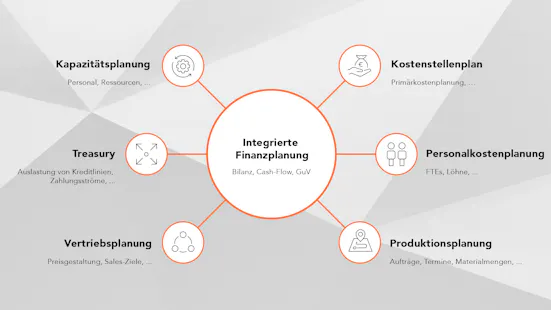
Planning & Forecasting
Department Planning
Why is departmental planning needed
Integrated financial planning is used by CFOs and financial managers to manage a company with foresight using financial key figures, to identify trends and to initiate measures to correct targets. Departmental planning is an important component of integrated financial planning. It details and refines the planning of individual departments. The planning results of individual departments are included in integrated financial planning as aggregated key figures. An important aspect of both integrated financial planning and departmental planning is the interdependence of the plans and thus the consistency of the financial ratios.
Examples of departmental planning are given below. It should be mentioned here that the descriptions are intended to give you an initial insight, but do not claim to be complete. If you have any further questions, please do not hesitate to contact us. We will advise you with passion.

Which Subjects are included
Cost center planning
Personnel cost planning
Sales Planning
Production Planning
Capacity Planning
Treasury
Integrated financial planning (balance sheet, cash flow, income statement)
demand-oriented planning modules
By planning resources – such as quantities, FTE or capacities – and monetary contributions, you obtain a comprehensible and consistent basis for controlling in the department as well as across departments.
Adequate planning granularity
Increase planning quality and effectiveness in the planning process
Consistent horizontal and vertical integration
Consideration of interdependencies between sub-plans and time dependencies between operational and strategic objectives
Focus on sub-plans that have an impact on results
Standardized and customized solutions
Added value of departmental planning
Departmental planning is created in the company because there is a need for forward-looking management. Here, however, it is important to ensure horizontal (to neighboring departments) and vertical (to Integrated Financial Planning) integration of departmental planning in order to keep the overall corporate planning process as efficient as possible.
The integration of departmental planning results in the following advantages for a company:
Improving the quality of planning
Detailing the overall plan with the help of departmental planning increases the informative value and plausibility of the overall plan
Single point of truth
Centralized, coordinated and consistent sub-plans that culminate in the overall plan
Transparency & speed
Transparency about where and how data is created. Speed through an orderly, in the optimal case system-supported, planning process
Our offer for you
We support you in taking an integrated view of the various specialist areas and transferring them as upstream subplanning to financial planning as monetary value planning.
Contact


